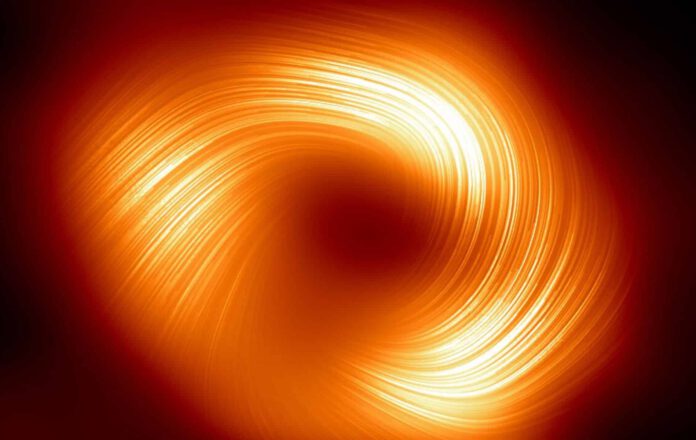
A New Perspective on the Black Hole in Our Galaxy
Newly acquired images offer a first glimpse of the black hole in our own galaxy illuminated in polarized light, revealing strong and organized magnetic fields spiraling from the edge of this supermassive black hole. This new perspective suggests the presence of a jet within our black hole, an intriguing thought that warrants further investigation.
The Collaborative Effort behind the Images
The images are the product of collaborative work by the Event Horizon Telescope Consortium, which in 2019 rose to prominence by capturing and showing the first images of a black hole. Initially, they focused on the black hole resident in the Messier 87 (M87) galaxy. In 2022, a capture of our ‘own’ black hole, Sagittarius A* (also referred to as Sgr A*) was made. A comparative analysis of the M87 black hole and our Milky Way counterpart revealed striking similarities between the two entities.
Do They Have Even More in Common?
The striking similarities raised questions about whether these black holes shared more than just physical features. To shed more light on this, scientists decided to study Sagittarius A* in polarized light. Their observations and findings based on these images have now been released.
Magnetic Field Structure
The images reveal strong and organized magnetic fields spiraling from the edge of Sagittarius A*. This magnetic field structure of our black hole has notable parallels with M87’s black hole. Previous studies indicated that such magnetic fields enable the black hole in M87 to shoot powerful jets of matter into space. Given this, the scientists speculate that a similar jet could be concealed within Sagittarius A*.
The Magnificent Findings
“Strong, tangled, and organized magnetic fields are present near the black hole in the center of the Milky Way,” explains Sara Issaoun, one of the researchers. “In conjunction with Sgr A* having a strikingly similar polarization structure to that in the much larger and more powerful M87* black hole, we have learned that strong and ordered magnetic fields are crucial for how black holes interact with the gas and matter in their vicinity.”
Polarized Light: What Exactly Is It?
These conclusions are drawn from observations of Sagittarius A* in polarized light. But what exactly is polarized light? In essence, light is nothing more than an electromagnetic wave that oscillates, or moves up and down. Sometimes, light oscillates in a preferred direction, this is known as polarized light. Polarized light is prevalent in our surroundings, but our eyes can’t distinguish it from ‘normal’ light. With regards to black holes, polarized light helps scientists map out their magnetic field lines. “By imaging the polarized light from glowing hot gas near black holes, we are able to directly infer the structure and strength of the magnetic fields that guide the gas and matter flow into and out of the black hole,” explains Angelo Ricarte, another researcher on the team. “Polarized light reveals much more about the astrophysics, gas properties, and the mechanisms that occur when a black hole feeds.”
The Observations
While it may sound daunting and complex, observing a black hole in polarized light is indeed very challenging. “Forming an unpolarized image is already challenging, given that Sgr A* is continuously moving while we’re trying to get a shot,” researcher Geoffrey Bower explains. It was therefore uncertain whether it was possible to create images using polarized light. However, this was achieved by connecting eight telescopes worldwide, forming a collective virtual telescope the size of Earth, known as the Event Horizon Telescope.
The Significance of the Findings
The new images and findings are fascinating, shares researcher Mariafelicia De Laurentis. “With a sample of two black holes – with very different masses and host galaxies – it’s important to determine the similarities and differences between them. They both exhibit signs of strong magnetic fields, which could indicate that this is a universal and possibly even a fundamental property of such entities. One possible similarity between these two black holes might be the existence of a jet, but while we have clearly imaged a jet from M87*, we haven’t yet found one in Sgr A*.”
Looking Into the Future
Future observations might bring changes. Astronomers are planning to continue studying Sagittarius A*, with new observations already scheduled for the coming month. There is hope that as more telescopes are added to the EHT, future observations will yield still better images and eventually high-definition movies of Sagittarius A*, revealing the hidden jet.











